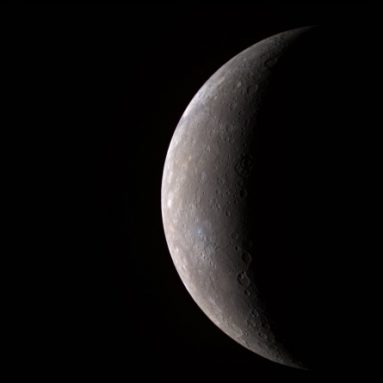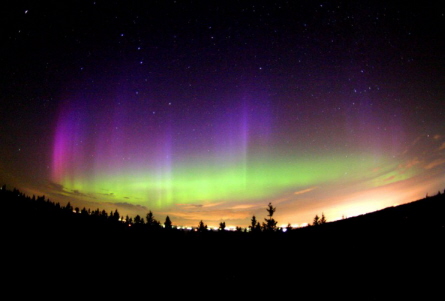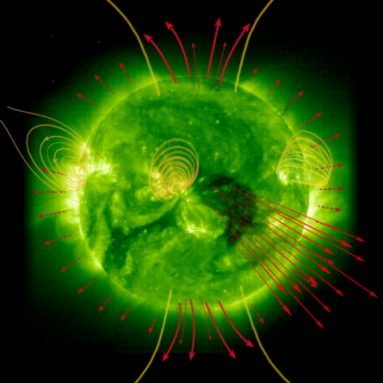Mercury’s magnetic twisters
The planet's strange atmosphere may have a lot to do with the sun.
If you look at pictures of Mercury taken with a high-powered telescope, the planet looks peaceful and calm. It’s tiny, barely bigger than our moon. Craters cover its surface. But up close, and seen with the right scientific instruments, Mercury sends out a different message. The sun, its nearby neighbor, blasts the tiny planet with radiation. And tornadoes whirling across Mercury are like nothing you’ve ever seen.
These twisters don’t destroy houses and cars and towns — because no one lives on Mercury. They don’t transport anyone to Oz — because, let’s face it, Oz isn’t a real place. They don’t form in the clouds — because Mercury doesn’t have clouds. And they’re not made of twisted columns of dust and debris — because Mercury doesn’t have wind or dust.
Tornadoes on Mercury are like nothing you’ve ever seen because they’re invisible. They form when part of the planet’s magnetic field twists up into a spiral. This opens up a connection between the planet’s surface and outer space. Tornadoes here are enormous — sometimes as wide as the planet itself. And they are transient: They can appear and disappear within a few minutes. On Earth, tornadoes form when two weather systems collide. On Mercury, magnetic cyclones show up when powerful forces, called magnetic fields, clash.
 |
|
This image is the first of Mercury taken by cameras on board NASA’s MESSENGER mission, in January 2008. MESSENGER has flown by Mercury three times and will start to orbit the planet next year.
|
| NASA, Johns Hopkins University Applied Physics Laboratory, Carnegie Institution of Washington |
Mercury’s magnets
Magnetic fields surround magnets and act like invisible shields. Every magnet, from the smallest refrigerator magnet to powerful magnets that can pick up cars, has a magnetic field around it. Magnets always have two ends, or poles, and the lines of the magnetic field go from one pole to the other.
Earth is actually a giant magnet, which means our planet is always surrounded by a powerful and protective magnetic field. The field is layered and thick, so it looks something like a giant onion that surrounds the Earth (except that it’s invisible). Earth’s magnetic field is easy to see in action with a compass: Because of the magnetic field, the compass needle points north. The lines of Earth’s magnetic field go from the North Pole to the South Pole. Earth’s magnetic field protects us from harmful radiation that flies through space — and it’s responsible for the northern lights, a beautiful and spooky display that twists in the sky in the far north.
 |
|
The aurora borealis, or Northern Lights, often appears as a curtain of fire in the sky. This spectacular light show has two main players: Earth’s magnetosphere and the solar wind.
|
| Philippe Moussette, Obs. Mont Cosmos |
Like Earth, Mercury has a magnetic field — though scientists didn’t know about it until the 1970s. In 1973, NASA sent a spacecraft to study Mercury. Over the following two years the tiny spaceship, called Mariner 10, flew by Mercury three times. After each flyby, it beamed information about the small planet back to scientists on Earth.
“One of the great surprises of that mission was this beautiful miniature planetary magnetic field,” says James A. Slavin. He’s a space physicist at NASA Goddard Space Flight Center in Greenbelt, Md. “That’s one of the reasons we’ve gone back with MESSENGER.” MESSENGER is NASA’s latest mission to Mercury, and Slavin is a scientist who works on the mission. MESSENGER, like the names of most NASA missions, is an acronym. It stands for “ MErcury Surface, Space Environment, GEochemistry, and Ranging.”
In September, MESSENGER finished its third flyby of Mercury. In 2011 it will begin a year of close observations of the planet. Using measurements from MESSENGER and Mariner, scientists have determined that Mercury’s magnetic field is puny compared to Earth’s — in fact, Earth’s magnetic field is 100 times stronger.
Mercury’s field is not only weak — it’s also leaky, notes Slavin. Using data from MESSENGER’s flybys, scientists found evidence that when Mercury’s magnetic field opens up, it takes the shape of these giant tornadoes. And if the scientists are right — and they still have to do more experiments to find out — then the tornadoes form because of a blast from the sun.
Blame it on the sun
Mercury is the closest planet to the sun, which means the sun’s heat and radiation are much stronger than on any other planet. On Mercury’s day side, temperatures soar to about 800 º Fahrenheit, but on the dark night side, they fall to about -300º F. Because of its location, Mercury is also affected by the solar wind.
The solar wind is like a high-energy stream — in this case, a stream of plasma — that blasts away from the sun in all directions at about one million miles per hour. That’s fast enough to get from the Earth to the moon in about 15 minutes. When the solar wind hits Earth, we barely notice because Earth’s powerful magnetic field protects everything on the planet.
But Mercury’s magnetic field is weak, so the solar wind can do some damage.
The solar wind is an example of space weather. On Earth, understanding the weather means measuring such things as rainfall, temperature and humidity. Understanding space weather means measuring powerful forces — energy from the sun — that can blast through space and affect even distant planets or other stars. To understand space weather on Mercury, scientists study electricity and magnetism.
The high-energy particles in the solar wind are a natural source of electricity. Scientists have known for centuries that electricity is closely related to magnetism. A moving magnetic field can generate electricity, and moving electric charges can form a magnetic field.
When the electric particles of the solar wind plow into Mercury, they’re also carrying a powerful magnetic field. In other words, Mercury’s puny magnetic field gets hammered by the one in the solar wind. As the solar wind blows toward Mercury, its magnetic field presses down on Mercury’s magnetosphere in some places and pulls it up in others. As these two magnetic fields tangle high above the planet’s surface, the magnetic fields twist together and grow — and a magnetic tornado is born. (Among themselves, scientists call these tornadoes “magnetic flux transfer events.”)
 |
|
Red arrows indicate the direction of fast solar wind streams leaving the sun. Yellow lines show magnetic fields in the sun’s atmosphere.
|
| European Space Agency, NASA |
“When one of these magnetic tornadoes forms at Mercury, it directly links the surface of the planet to the solar wind,” Slavin says. “It punches a hole in Mercury’s magnetic field.” And through that hole, he says, the solar wind can spiral down, down, down — all the way to the surface.
Mercury’s moving atmosphere
Mercury’s magnetic tornadoes are more than just a powerful force of nature. They may explain another of Mercury’s mysteries. NASA’s missions to Mercury have shown that, in another surprise, the planet has a thin atmosphere. An atmosphere is the bubble of particles that surrounds a planet or star: On Earth, the atmosphere contains the gases we need to breathe (as well as other gases). The atmosphere is held to Earth by the force of gravity.
Because Mercury is so small, however, scientists used to think that it did not have enough gravity to hold an atmosphere in place. That changed when Mariner 10 — and now MESSENGER — went to Mercury and found evidence of a thin, ever-changing atmosphere. It isn’t made of such light gases as oxygen suitable for breathing, however. Instead, Mercury’s atmosphere seems to be made of atoms of metals, such as sodium. Even more mysterious, scientists found that Mercury’s atmosphere appears and disappears in different spots all over the planet. It rarely stays in one place for long, and sometimes seems to move across the planet.
“One day you may see atmosphere at Mercury’s northern pole, the next day you may take an image and see more atmosphere over the southern atmosphere — or even at the equator,” Slavin says.
Slavin and his team now suspect that the Mercury’s strange atmosphere — or at least part of it — may actually be created by the magnetic tornadoes. When a tornado opens up, the solar wind can wind down to the surface of the planet. Its particles are so powerful that when they strike Mercury’s rocky surface, atoms fly up, up, up — and then gravity pulls them back down.
A magnetic tornado can be as wide as the entire planet, so sometimes the solar wind may blast half the planet at once. This sends up a lot of atoms, over a giant chunk of the planet’s surface, flying up like teeny baseballs that have just been hit out of the ballpark — and coming down again, eventually.
The magnetic tornadoes may last only a few minutes, which means the solar wind has only a few minutes to stir up atoms on Mercury’s surface. But the tornadoes happen frequently, which means the atmosphere may show up in one place, disappear minutes later — and show up again somewhere else on Mercury.
“It looks like the patchiness [of the atmosphere] is the effect of a very rapidly changing solar wind source,” says Menelaos Sarantos, a NASA research scientist with the Goddard Earth Sciences and Technology Center in Greenbelt, Md. “That was unexpected.”
If MESSENGER is watching when this happens, then these atoms flying above Mercury’s surface start to look like an atmosphere — a resemblance that could begin to answer some of the puzzling questions about Mercury.
Slavin says solar wind blasts and magnetic tornadoes may not be creating all of Mercury’s atmosphere, but they probably help a lot. “Ultimately, it’s at least contributing to these variations in Mercury’s metallic atmosphere,” he says.
But it will take more missions to Mercury before all the mysteries have been solved. One thing scientists have learned from Mariner 10 and MESSENGER, says Sarantos, is that the atmosphere changes quickly on tiny Mercury. Scientists may have to change the way they’re using MESSENGER’s instruments — studying what happens within a minute, rather than what happens within an hour.
“What surprised me the most is how fast things are happening,” says Sarantos. “We thought fast meant variations on a daily basis, but the suggestion of variations in a matter of minutes is too fast for us who analyze these measurements”.”
The message from MESSENGER — and from Mariner 10 — is that we still have a lot to learn about Mercury. It’s no quiet pilgrim running around the sun. Instead, with its weak magnetic field, it’s like a miniature Earth whose size and place near the sun lead to strange and unexpected natural phenomena, like giant tornadoes and a disappearing atmosphere.
“This is a marvelous example of space weather at another planet,” Slavin says.
Going Deeper:
See the latest pictures of Mercury and keep up with the latest news from the Messenger mission: http://www.nasa.gov/mission_pages/messenger/main/index.html
Explore the Northern Lights with this site from the Exploratorium science museum: http://www.exploratorium.edu/learning_studio/auroras/
Learn more about Mercury: http://solarsystem.nasa.gov/planets/profile.cfm?Object=Mercury
Sohn, Emily. 2008. “Mercury unveiled,” Science News for Kids, February 27. http://sciencenewsforkids.org/articles/20080227/Feature1.asp
Cutraro, Jennifer. 2008. “The trouble with Pluto,” Science News for Kids, October 8. http://sciencenewsforkids.org/articles/20081008/Feature1.asp
Cowen, Ron. 2009. “MESSENGER’s second pass.” Science News, April 30.
http://www.sciencenews.org/view/generic/id/43369/title/MESSENGER%E2%80%99s_second_pass
TEACHER’S QUESTIONS
Here are questions related to this article.







